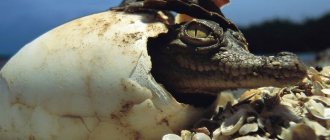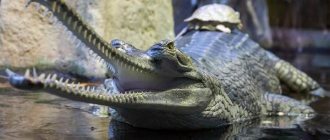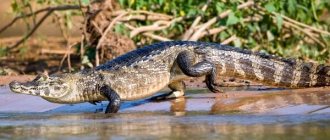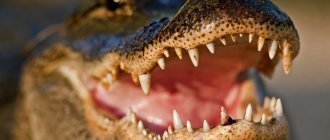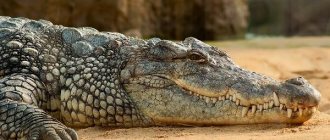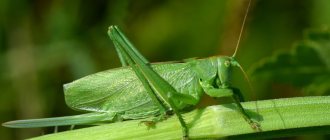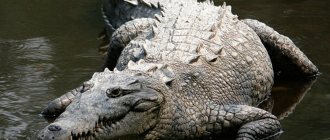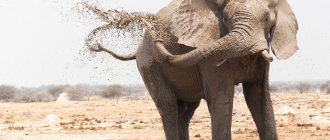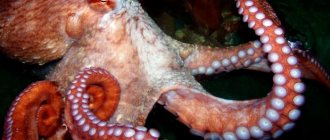Alligator Conservation
Photo: Big alligator
Even if Chinese alligators disappear in nature, they will still survive as a species: thanks to successful breeding in captivity, in zoos, nurseries, and private collections, there are approximately 10,000 of them. This allows them to be successfully bred and subsequently to be able to introduce the species into the natural habitat or another area.
But it is still important that they are preserved in the wild, and measures are being taken for this: the Chinese authorities have created several nature reserves, but so far it has still not been possible to completely stop the extermination of alligators even in them. Work is being carried out with local residents, strict prohibitions are being introduced and control over their implementation is being strengthened
This gives hope that the population decline in the Yangtze River basin will be stopped.
In addition, in recent years, an experiment has been carried out to introduce Chinese alligators in the state of Louisiana, and so far it has been successful - it may be possible to achieve their faster reproduction in more favorable natural conditions. If the experiment is considered successful, it may be repeated in other areas of the United States. Here they will coexist with their Mississippian relatives: but no additional measures are being taken to protect them - fortunately, there is no threat to the species.
Powerful alligators, although worth admiring from a distance, are beautiful and powerful predators that have remained almost unchanged for many millions of years. These reptiles are one of the important components of the fauna of our planet, and they certainly do not deserve the barbaric extermination to which Chinese alligators are subjected.
Tags:
- Alligatorinae Gray
- Alligatoroidea
- Archosauriformes
- Loricata
- Alligator
- Alligators
- Archosauromorphs
- Archosaurs
- Deuterostomes
- Bilaterally symmetrical
- Diapsids
- Swamp animals
- Animals of reservoirs
- Animals of China
- Animals starting with the letter A
- Lake animals
- Animals of the rivers
- Animals of North America
- Animals USA
- Animals of South America
- Crocodylomorphs
- Crocodiles
- Carnivores
- Vertebrates
- Pseudosuchians
- Chordates
- Ghostostomes
- Quadrupeds
- Eusuchia
- Eumetazoans
What is the difference between the diet of a crocodile and an alligator?
Reptiles of these species spend a significant part of their time in the aquatic environment, and come to the coastal shallows in the early morning or closer to dusk. Representatives of the crocodiles order hunt their prey at night. The diet is largely represented by fish, but any prey that the reptile can handle can be eaten. Juveniles use a variety of invertebrates as food, including insects, crustaceans, mollusks and worms.
Older individuals hunt fish, amphibians, reptiles and aquatic birds. Large alligators and crocodiles, as a rule, easily cope with fairly large mammals. Many species of crocodiles are characterized by cannibalism, which consists in devouring smaller representatives of the genus by the largest individuals from the order of crocodiles. Very often, both crocodiles and alligators eat carrion and half-decomposed prey.
What do small crocodiles eat?
As for products, small crocodiles are fed mainly with laboratory mice, frogs, insects, and day-old chicks. Supplementing the diet with beef liver or just beef to provide sufficient calcium and vitamins, C and B1.
Interesting materials:
How many Persians are there in Dota 2022? How many pixels is normal? How many centimeters is the baseboard? How many approaches should you do to the plank? How many pull-ups is normal in the army? How many died in the Winter Cherry of Kemerovo? How much does a chemist earn in Germany? How much does a math tutor earn? How much does a counselor at camp Artek earn? How much do intersection workers earn?
Caiman
A caiman is an animal belonging to the genus of reptiles and the alligator family. They live in both Americas.
Today there are 3 types of caimans known:
- Crocodile.
- Wide-faced.
- Paraguayan.
In terms of their morphology, caimans are very similar in appearance to alligators; they differ only in the presence of osteodorm bone plates on the surface of the abdomen. On the head of caimans there is a bony ridge that runs across the bridge of the nose and ends just below eye level.
Crocodile caiman
The maximum length of the animal is about 3.5 meters, and its weight reaches up to 200 kilograms. The male caiman is twice the size of the female.
Mating and reproductive behavior
According to one study, 70% of female alligators can mate with one male each breeding season. However, this behavior is not typical of female crocodiles. A study of crocodile litters has determined that the young may contain genes from different males.
These are the names of the same animals. However, this is not a correct opinion, because crocodiles (Crocodilus) and alligators (Alligator) are relatives, but belong to different families of reptiles. So let's decide who is bigger: an alligator or a crocodile, and how else they differ from each other.
Alligators are significantly smaller than crocodiles.
The largest of the crocodile species is considered to be the saltwater crocodile. This is a real giant that can reach seven meters in length and weigh two tons. Just imagine this huge thing: if you put it on its tail, it will be as tall as a three-story building! Alligators are much smaller and inferior even to Nile crocodiles, which do not grow longer than five meters. The larger Mississippi alligators do not grow larger than 3.4 meters, and the smaller Chinese alligators do not grow longer than two meters. Male Mississippi alligators weigh about 220 kilograms, females - 90-100 kilograms. Chinese alligators are much lighter. With an average length of one and a half meters, they weigh only 36-45 kilograms.
Crocodile
Accordingly, alligators are more agile and mobile
. Although crocodiles can be very agile and reach speeds of up to 17 km/h, alligators are still faster and can move in the water at speeds of over 30 km/h.
A distinctive feature of a crocodile is its teeth.
They have such a jaw structure that
their teeth stick out even when their mouth is closed
. Especially the longest fourth tooth - it immediately catches your eye. A crocodile can also be identified by its face. It has a sharp shape and resembles the letter V. Alligators have a normal jaw structure and a blunt, short and slightly flattened U-shaped snout.
Another “legendary” difference between crocodiles and alligators is “crocodile tears”.
There is a legend that crocodiles sometimes cry.
Some even suggest that the crocodile “cries” while devouring its victim, hence the understanding of this expression as a figurative transmission of hypocritical behavior. “Tears” actually sometimes flow from the crocodile’s eyes. But this happens, of course, not from an excess of emotions, but because of the structure of salt metabolism. With the help of the lacrimal and lingual glands, excess salts are removed from the crocodile's body. Thanks to this feature, crocodiles can live in salt water. Alligator
Alligators lack lacrimal and tongue glands, so they do not “cry” and cannot live in salt water.
They live exclusively in fresh water in China and North America.
Crocodiles and alligators also differ in skin color.
The muzzle of alligators is covered with small black spots. These are sensors that detect the approach of prey. The skin of crocodiles is completely covered with such spots.
It is curious that, unlike meat-eating crocodiles, alligators can also eat plant foods.
, that is, leaves and fruits. Crocodiles feed exclusively on fish or meat.
In general, it is better not to approach either one or the other, because these are quite dangerous predators. So watch for crocodiles and alligators safely.
What is the difference between a crocodile and an alligator and gharial?
In general, it is not difficult to distinguish a crocodile from an alligator by appearance; you just need to look carefully at their faces. The first thing you should pay attention to is the end of the muzzle: in a crocodile, the muzzle is always narrower, V-shaped, while in alligators, it is wide and blunt - U-shaped.
Also, the skull of a crocodile is usually higher than that of alligators. But the main difference is the structure of their jaws and the location of their teeth. With the jaws of a real crocodile closed, we can see its 64-68 relatively longer and sharper teeth, including a particularly large fourth tooth on the lower jaw.
Photo of the difference between a crocodile and an alligator and gharial
In alligators, the teeth are more numerous - their number varies between 74-80 pieces, but these teeth are much smaller, have blunted crowns, and the fourth tooth of the lower jaw does not stand out among the rest and the upper jaw completely covers it.
Additionally, most crocodiles are often lighter in color than alligators.
Caimans differ from crocodiles in the same characteristics as alligators, since they are representatives of the same alligator family. On average, caimans are smaller than other species in the group.
Gharials occupy a special position in the group. These large animals are allocated to their own family - gharials. They are sharply distinguishable from all other species due to their very narrow, pincer-shaped snout, indicating their diet of fish.
Gangetic gharial
Despite their very large size, gharials are not at all dangerous to humans, since their jaws are relatively weak and are not designed to catch large mammals.
Habits
When considering the question of how a crocodile differs from an alligator, one cannot help but recall their behavior, or rather their habits. What characteristic feature comes to mind first when thinking about these predators? That's right, aggressiveness. There is an opinion that the alligator is less bloodthirsty than the crocodile. On the other hand, it should be understood that all this is relative. After all, none of these reptiles will release prey from their teeth if they manage to grab the victim. And although no one would dare to call alligators good-natured creatures, nevertheless they are just paws compared to crocodiles, which grow up to 7 meters and weigh more than a ton. These monsters, especially the Nile ones, actively hunt not only large animals, but also people.
Magazine
Water 12/30/2018
There are many similar animals that people confuse or call incorrectly. For example, jaguars and leopards, African and Asiatic lions, the same story with crocodiles, and today we’ll talk about them. In fact, all the animals mentioned in the title are crocodiles. So, in principle, you can continue to confuse them, but on one condition: if you are not sure who exactly is in front of you, then call them crocodiles, not alligators!
Why is that? The fact is that they all belong to the same order of reptiles - crocodiles. But then everything is a little more complicated.
The order of crocodiles includes three families. And here you need to be more careful. This is what a squad of crocodiles looks like:
- alligator family - true crocodiles family - gharial family
All three families have differences, both internal and, of course, external. We won’t talk about the insides today, but we will look at their external differences, so as not to be confused in the future.
Alligator
This family includes two subfamilies: the subfamily Alligatorinae and the subfamily Caimaninae and several more genera and different species.
Subfamily Alligatorinae.
There were many genera in it, but all but one became extinct:
Genus of alligators: - Chinese alligator - Mississippi alligator
The main visual difference between representatives of the alligator genus and real crocodiles is the structure of the head. The alligator's muzzle is more flattened and wider. When the mouth is closed, the teeth are completely or almost completely hidden.
Subfamily Caimaninae.
It also has many extinct genera, but there are three living ones:
Genus Paleosuchus -Cuvier's smooth-faced caiman -Schneider's smooth-faced caiman Genus Caiman -Jacar caiman -Crocodile caiman -Broad-snouted caiman Genus Melanosuchus -Black-backed caiman
It is easier to confuse a caiman with a real crocodile, because many caimans have visible teeth even with their mouths closed. However, the teeth and jaw are relatively small, and the caimans themselves are generally smaller than real crocodiles.
Real crocodiles
This family includes three genera and 14 species of different crocodiles; listing them all is boring. Let us pay attention only to the most famous species of real crocodiles - the Nile crocodile. It can be called the standard of all crocodiles.
In general, the family of true crocodiles includes the two largest species of crocodiles in the world - the saltwater one and the Nile one. These guys are not only very big, but also extremely aggressive. A Nile crocodile can easily attack a hippopotamus or even a rhinoceros. Alligators, of course, can be large (up to 4.5 meters), but this is not so common. But real crocodiles grow up to 7 meters and can weigh up to two tons!
Gharialidae
This family includes only two living species: the Gangetic gharial and the gharial crocodile. They are also smaller than true crocodiles and not as aggressive. It is impossible to confuse gharials with alligators and real crocodiles if you know what they look like. And they look very funny - they have very thin and narrow muzzles.
Well, now let's fix it:
– Gharialidae
– funny creatures with a narrow muzzle
– Alligator
- have a flattened, wide muzzle. Their teeth are only visible when their mouth is open. Except for caimans, whose teeth are visible, but the mouth is relatively small. Alligators live in central and northern America and China. Moreover, representatives of the alligator genus are generally found only in two countries - the USA (Mississippi alligator) and China (Chinese alligator).
– Real crocodiles
found on all continents except Antarctica. If you meet a crocodile in Africa, then you can safely say that it is a representative of the family of real crocodiles. The structure of the jaw of a real crocodile is such that even with its mouth closed its teeth stick out. The mouths of real crocodiles are larger and more powerful than those of alligators. The muzzle of a real crocodile has a pointed V-shape.
If we summarize all this, the conclusion is simple: the main difference between all representatives of the crocodile order is the structure of the jaw and the shape of the head.
Now let's check how you have mastered the material. All of you have known the crocodile Gena since childhood. Below is a picture of it. Which family of crocodiles do you think Gena belongs to?
Right! Alligator!
Photo (last): frame from the cartoon “Crocodile Gena and Cheburashka”
Text author: Alexey Osokin
Natural enemies of alligators
Photo: Alligator Red Book
In nature, like other representatives of crocodiles, they are at the very top of the food chain. But this does not mean that they may not be afraid of other animals: panthers and bears can pose a serious threat to them. However, the opposite is also true - alligators can also deal with them and eat them. But such situations are quite rare.
Other alligators are a greater threat - cannibalism is common among them; adult and strong individuals do not hesitate to hunt smaller and weaker fellow tribesmen. This phenomenon becomes especially frequent if the population in the nearby territory has become too high - then there may not be enough easy prey for everyone.
Top articles: Geography, history, environmental threats and Mediterranean states
Alligators themselves, in addition to their relatives, can be threatened by otters, raccoons, snakes and birds of prey. They are also sometimes attacked by large fish. For older, but still young individuals, lynxes and cougars are a serious threat - these felines usually do not attack on purpose, but cases of conflicts between them and alligators have been recorded.
After the Mississippi alligator grows to 1.5 meters, it has no enemies left in nature. The same is true for the Chinese, although they are smaller. The only and most dangerous enemy for them is man - after all, since ancient times people have hunted crocodiles, including alligators, and exterminated them.
How long can an alligator go without eating?
The reptilian will go hungry for 9 whole months, until the giant herd circles around Tanzania and returns back to the river. In general, 9 months without food is far from a record. According to various sources, crocodiles may not eat for 1.5 to 3 years.
Interesting materials:
What does a star mean? What does the asterisk at the top of the screen mean? What does calling to your home region mean? Where are the auditory ossicles located and what is their significance? What does the name Victoria mean? How out of a bucket is the meaning of a phraseological unit? How does the value of ionization energy change in periods and subgroups of the periodic table of elements? How to change the range of the vertical axis of values in Excel? How to change aperture value on Canon? How to change TTL value on computer?
Legendary prehistoric crocodiles
The giant crocodile Sarcosuchus is considered one of the largest ancestors of predators during the Mesozoic period - its length reached 12 meters, and thanks to its sharp, needle-like teeth, it could even attack dinosaurs. In many ways, the Gangetic crocodile is similar to it, although, of course, its dimensions cannot be called as stunning. Deinosuchus had a very impressive size with a length of up to 14 meters and a body weight of about 8 tons. According to experts, the force of its bite was no less than that of a tyrannosaurus. Not a single endangered species of crocodiles of our time can boast of such parameters. Another reason to consider Deinosuchus unique is that they are the most ancient individuals that were crocodiles, and did not belong to the alligator family.
In the Miocene era, purussaurs lived on our planet; their length was 10 meters, while its skull was one and a half meters long and they were even more massive than Deinosuchus. If we talk about the longest crocodiles in history, then these were the rhamphosuchus that lived in the Cenozoic, whose body could grow seventeen meters and weigh about 8 tons.
Crocodiles of the twenty-first century seem very small in comparison with ancient individuals, although this does not prevent them from remaining deadly.
It is in vain that some people believe that crocodiles are stupid. These animals are not only smart, but also cunning and hardy. After all, they survived for many millions of years, which indicates their adaptability to existence - these are the laws of evolution that cannot be circumvented. To this day, these scaly reptiles live in various parts of our planet.
Alligator
Alligators are animals belonging to the crocodile family, including the American and Chinese species of alligator. The habitat gave the names to the species.
Appearance Features
Among the distinctive features of the alligator, it can be noted that their eyes are located higher, their muzzle is wider and their color is darker. The color can vary depending on the habitat - it acquires a green tint in water with a lot of algae, and in water where the shadow of vegetation falls, it darkens.
If we talk about the length of the body, then large representatives of the American species do not grow more than 4.5 m, and Chinese crocodiles do not exceed 2 meters in length.
Conclusions TheDifference.ru
- The number of species of crocodiles exceeds the number of species of caimans.
- The main difference between caimans and other crocodiles is the structure of their jaws.
- Caimans cannot shed “crocodile tears” - they lack periocular glands.
- Crocodiles have a wider distribution area than caimans.
Publication date: 10/02/2013
Sources used:
- https://raznisa.ru/v-chem-raznica-mezhdu-kajmanom-i-alligatorom/
- https://zen.yandex.com/media/id/5a71b86b8c8be3426d4e49f2/kaiman-krokodil-i-alligator-pokazyvaiu-chem-oni-otlichaiutsia-drug-ot-druga-5fcccbe48f8c7853ed4c26b1
- https://vchemraznica.ru/chem-otlichaetsya-kajman-ot-krokodila-osobennosti-i-otlichiya/
- https://thedifference.ru/chem-otlichaetsya-kajman-ot-krokodila/
Features of character and lifestyle
Photo: Alligator
They swim well and quickly, using their tail for rowing. They can also move quickly on land - they reach a speed of 20 km/h, but are able to maintain this pace only over a short distance. You can often see them resting on land, and they usually open their mouths to allow the water to evaporate faster.
At first, young alligators remain in the same place where they were born, but when they grow up, they begin to look for a new habitat. If young animals live in groups, then adults settle alone: females occupy smaller areas, males tend to occupy a larger one.
They love slow-flowing water, and can sometimes create ponds using their tails. Then they become overgrown and populated by small animals. They live only in fresh water, although sometimes they can swim into salt water and stay there for a long time - but they are not adapted for permanent residence in it.
The tail is also used for digging holes - complex and winding ones, stretching for tens of meters. Although most of such a hole is located above water, the entrance to it must be underwater. If it dries out, the alligator has to dig a new hole. They are needed as a shelter in the cold season - several individuals can winter together in them.
Although not all alligators go into holes - some hibernate right in the water, leaving only their nostrils on it. The reptile's body freezes into the ice, and it stops responding to any external stimuli, all processes in its body slow down very much - this allows it to survive the cold. Long hibernation is typical for Chinese alligators; Mississippi alligators can fall into it for 2-3 weeks.
If alligators managed to survive the most dangerous period of growing up, then they can reach 30-40 years. If conditions are favorable, they sometimes live even longer, up to 70 years - this is difficult to find in the wild, since older individuals lose speed and cannot hunt as before, and due to their large size, their body requires food no less than before .
How does a crocodile hunt?
Crocodiles spend most of the day in the water, and hunt only after dark. The reptile swallows small prey whole. In a duel with a large prey, the crocodile's weapon is brute force. Large land animals, such as deer and buffalo, are guarded by a crocodile at a watering hole, attacked suddenly and dragged into the water, where the victim is unable to resist. Large fish, on the contrary, are dragged into shallow water, where it is easier to deal with prey.
The massive jaws of a crocodile easily crush a buffalo’s skull, and strong jerks of the head and a special “deadly rotation” technique instantly tear the prey apart. Crocodiles do not know how to chew, therefore, having killed the victim, they twist out pieces of suitable flesh with their powerful jaws and swallow them whole.
Crocodiles eat quite a lot: one lunch can account for up to 23% of the mass of the predator itself. Often crocodiles hide part of the prey, but the supply does not always remain intact, and is often consumed by other predators.
Crocodile caught a shark
Crocodile
Crocodiles are animals from the order of aquatic reptiles. Representatives of the order are divided into 22 species and families of gharials, alligators and true crocodiles. Based on this classification, we can conclude that crocodile is a broader concept.
The name of the animal in Greek is crocodile, which translates as “pebble worm.” It can be assumed that this is due to the characteristics of the skin - the tubercles on it look like pebbles, and the writhing movements resemble the movements of a worm.
Crocodiles are ancient animals and are related to dinosaurs. Their appearance on the planet dates back to the Cretaceous period - approximately 83.5 million years ago.
Appearance Features
Some distinctive characteristics, such as length, weight and coloring, are influenced by species - body length varies from 2 to 5.5 m, weight - from 400 to 700 kg. Sometimes the length of large individuals reaches 7 m. It should be noted that males are 2-2.5 times larger than females when comparing representatives of the same species.
The large head of the crocodile with an elongated narrow muzzle is flattened, connected to the elongated and flattened body by a short powerful neck. A very mobile tail with strong muscles on the sides and narrowed. All these structural features make it possible to move freely in water with the least resistance and high speed.
The paws, compared to the length of the body, are short, located laterally, there are 5 toes on the front ones, and the absence of little fingers is characteristic of the hind ones. It seems that it is inconvenient for a crocodile to move on such paws, but in reality it gallops quite quickly, developing a speed of 14-17 km/h; in water it moves faster - 30-35 km/h.
An interesting feature of crocodiles is that in order to see what is happening on the surface of the water when underwater, the eyes, nose and ear openings are located closer to the top of the head
Best articles: What are Calanques?
The structure of the eyes also attracts attention - the vertical pupils are narrow, the eyeball is protected by the third eyelid and is washed with tears from the lacrimal glands. The mouth is filled with a large number (72-100) sharp conical teeth up to 5 cm in length
The mouth is filled with a large number (72-100) sharp conical teeth up to 5 cm in length.
Rows of hard horny scutes are visible on the skin of the reptile, the color of which directly depends on the habitat and belonging to a particular species.
Due to the peculiarities of salt metabolism, crocodiles can live in both fresh and salt water, but, importantly, they lay eggs only on the ground. Life expectancy varies - from 80 to 100 years
Do crocodiles cry?
Anyone who has had to watch a crocodile closely for a long time will say with confidence - yes, they are crying. “Crocodile tears,” as they are commonly called, are nothing more than salts that are removed from the body with the help of the lacrimal glands in case of excess. There are salt glands on the surface of the tongue.
The expression “crocodile tears” can be interpreted as tears of insincerity, pretense, because the crocodile cries not out of pity for the victim, as it might seem, but for a reason related to the state of the body.
Interesting things about crocodiles:
- a person is prey for a crocodile, but it is attacked mainly by representatives of the most aggressive species - the Nile and combed crocodile;
- among many ancient peoples it was an object of worship and was considered a sacred animal;
- in Egypt, nobles in ancient times kept it as a pet;
- the force of compression of the jaws of a combed crocodile can be compared with the force of closing the jaws of a killer whale or sperm whale;
- due to the high demand for crocodile skin for various products, animal populations are declining;
- Large reserves of fat and slow metabolism allow the crocodile to go without food for a year.
Alligators are animals belonging to the crocodile family, including the American and Chinese species of alligator. The habitat gave the names to the species.
Appearance Features
Among the distinctive features of the alligator, it can be noted that their eyes are located higher, their muzzle is wider and their color is darker. The color can vary depending on the habitat - it acquires a green tint in water with a lot of algae, and in water where the shadow of vegetation falls, it darkens.
If we talk about the length of the body, then large representatives of the American species do not grow more than 4.5 m, and Chinese crocodiles do not exceed 2 meters in length.
General description of the group: similarities of crocodile, alligator, gharial
For the first time on our planet, animals of this small group in terms of species composition appeared 83.5 million years ago, at the end of the Cretaceous period. These are the "remnants" of a much larger group of animals, called crocodylomorphs by zoologists, which in turn evolved from thecodonts about 225 million years ago, at the end of the Triassic period.
photo of Nile crocodile
Most of the crocodylomorphs died out at the beginning of the Cenazoic era, that is, around the Paleogene, and to date only crocodiles have survived.
The crocodile order includes three families:
- crocodiles (Crocodylidae),
- alligators (Alligatoridae),
- gharials (Gavialidae).
These are large, lizard-like reptiles that inhabit the shores of water bodies. In all representatives of the group, the skin of the dorsal part of the body is covered with durable, richly sculptured, often comb-shaped scutes, while the lower, abdominal part is softer, flat, without any sculpture.
Mouth and teeth of a crocodile
The body of these animals is very massive and thick. The toes of relatively short paws have powerful claws, which are used for digging nests for oviposition. The front paws have five toes, and the hind paws, due to the absence of a little finger, have four, connected by a small membrane.
The head is massive, with elongated jaws containing powerful teeth. The eyes are relatively small, with a vertical pupil. The nostrils are located at the end of the muzzle and are equipped with special valves that close while the animal is immersed under water.
The tail is very strong, in large individuals, capable of knocking down a person or any large animal; it is thick at the base, gradually flattens towards the end from the sides and serves as a “rudder” during swimming.
All members of the order are excellent swimmers, but on land they are generally slow, but on occasion they can even gallop short distances.
As you know, all crocodiles are predators. The prey of large species is often large ungulate mammals, such as zebras, various types of antelope, pigs, deer and even giraffes.
Many crocodiles in the water
Small and medium-sized species are usually content with smaller prey, their "catch" usually being fish, reptiles, amphibians and waterfowl.
As a rule, several individuals gather in one small area, often up to several dozen. Being food competitors, nevertheless, when hunting large prey, crocodiles provide each other with some assistance.
Since the crocodile is unable to swallow prey larger than its mouth, it is forced to tear out large pieces of the victim's flesh. This is the “help” of fellow humans. Having grabbed hold of different parts of the body of large prey with their teeth, crocodiles begin to rotate opposite each other, as if twisting pieces of flesh.
All crocodiles lay eggs. To do this, females sometimes dig quite deep holes in the coastal soil, which they then carefully bury, laying their eggs there. Some species rake a mound of partially rotted leaves and other debris on top in order to ensure a suitable temperature regime.
Gavial – photo
If possible, females usually remain near the clutch, protecting the eggs from enemies. All eggs hatch at the same time. An interesting feature of crocodiles is the fact that initially their embryos do not contain information about gender.
Sex is determined solely by the incubation temperature of the eggs. So, if the egg was stored at a temperature of 31 to 32 ° C, then males are hatched, if higher or lower, then females are hatched.
Young crocodiles are still inside the eggs, at the time of hatching they make croaking sounds, and the mother crocodile, digging up the clutch, helps the offspring get out and carries them in her mouth to the reservoir, however, this behavior is not observed in all species.
The presence of baroreceptors in the crocodile's mouth allows the female to be extremely careful when transferring her offspring to a reservoir.
Crocodile teeth
In addition to their own cubs, females sometimes accidentally pick up and carry into the water the cubs of some turtles, which lay eggs for safety near the crocodile’s clutch (turtle cubs hatch at the same time as the crocodile cubs and are also able to reach the water on their own).
Many crocodiles reach sexual maturity no earlier than ten years of age. The life expectancy of crocodiles is also high - up to 150 years or more.
Crocodile
A crocodile is a reptile that leads a semi-aquatic lifestyle and belongs to the order of crocodiles.
This wild animal received its own name thanks to the Greek language, in which the word “crocodilos” literally means a pebble worm. In ancient times, the people who inhabited the Peloponnese called this the reptile itself, which has lumpy skin that resembles a pebble in appearance, and its too long body and characteristic method of movement reminded people of a worm.
Crocodile
The crocodile is a unique animal because it is the surviving archosaur. The closest relatives of the crocodile are considered to be birds, which are also the closest relatives of the same archosaurs.
The length of the animal can be up to 5.5 meters, and its weight can be from 400 to 700 kilograms, while its head alone weighs about 200 kilograms. Crocodiles are famous for their very pronounced sexual demorphism: females are 2.5 times larger than males.
The reptile has a very interesting body structure:
- Flattened head.
- Long muzzle.
- Elongated flattened body.
- Mobile tail, compressed on the sides.
The animal has short legs on both sides of its body. In terms of its skull structure, the crocodile is very similar to a dinosaur. The eyes, nostrils and ears of a reptile are located on the top of the head. Thanks to this feature, a crocodile can lie under the water column and simultaneously smell prey with its exposed nostrils.
The crocodile has a four-chambered heart, and the animal’s blood contains antibiotics that effectively prevent infections during prolonged exposure to dirty water.
The growth of a reptile does not stop throughout its life. The crocodile is a predator; it feeds on fish, birds, animals, turtles, and there are frequent cases of attacks on humans.
Crocodiles are distributed throughout almost the entire planet Earth; they can be found in Africa, the Philippines, Guatemala, Japan, Bali, and North and South America.
Crocodile for the most part prefers to live in fresh water, but they can also live well in salt water.
The reptile leads a semi-aquatic lifestyle: they spend a lot of time in the water, but every morning they prefer to sunbathe on the shore; even crocodiles prefer to lay eggs on land.
Comparison
Considering that caimans are only one of the families of the order Crocodiles, they share a common “basic kit”. This includes a body shape characteristic of lizards with a powerful tail equal to the length of the body and head. The animals are covered with horny scutes growing in parallel rows, and have a special skull shape that makes them the most similar among all reptiles to extinct dinosaurs. Like all reptiles, crocodiles are cold-blooded, but unlike turtles, snakes and lizards, they have a four-chambered heart. Today there are 23 species of crocodiles on Earth.
Saltwater crocodile
The Cayman family includes only three species of animals - the crocodile, broad-nosed and Paraguayan caiman. It is believed that the main difference between caimans and other crocodiles is the structure of their jaws. In crocodiles they are wide at the base and end with a sharp end. The upper jaw hangs slightly over the lower jaw. Caimans have slightly shorter jaws that end softly and rounded. The upper jaw is slightly shorter than the lower jaw. The baby caiman's jaws look snub-nosed and cute, comparable to a duck's beak.
Another difference is the desire of caimans to exist exclusively in clean and fresh water, while there are crocodiles that live in salt water (Australian) or in the waters of a muddy river (Nile or Chinese crocodiles). This happens because caimans do not have special glands near their eyes that regulate water-salt balance, that is, caimans cannot and do not shed “crocodile tears.”
The lack of such an important skill is associated with the limited distribution area of caimans. These animals can only be seen in rivers and lakes of Central and South America with appropriate water parameters. Other representatives of the order Crocodiles can be found on all continents except Antarctica, in the equatorial, subequatorial and tropical climate zones.
Baby animals
Let's start with pets. They catch the eye of children more often, and therefore arouse greater interest.
Sheep
Let's look at what a baby sheep is called. Many people living in cities do not even realize that sheep and ram are one type of animal, only female and male. Their baby is not called a ewe or lamb, but a lamb.
Pig
Pigs are one of the first animals to be domesticated by humans. They belong to the order Artiodactyls. They supply people with meat and lard. The female pig is called a sow or pig, and the male is called a boar or boar. But their baby is called not a pig or a hog, but a piglet.
This is interesting! The Slavs called a male pig a poros. The addition of the suffix “enok”, again, means a reduced form. Hence the name - piglet.
By the way, the birth of piglets is called farrowing, and a pregnant pig is called gestation.
Cow
Cows have been tamed by humans since ancient times. They give people meat and milk. The male cow is called a bull, and the baby is called a calf. Another example of the fact that children and parents have different roots.
Experts still cannot figure out where the word calf came from; there are only guesses. One of them is that among the ancient Slavs this word meant “born”, but cows bear their offspring for 9 months.
Turkey
America is the homeland of turkeys. But in recent centuries, this bird has been grown in European countries.
This is interesting! Few people know that turkeys are named after their homeland. Previously, America was called the West Indies, so the name of the birds is translated as Indian rooster.
In this case, parents and their children have the same root. A female turkey is called a gobbler or turkey, and her baby is called a poult.
Rabbit
Another domestic animal is the rabbit. The female is called a rabbit, the male is called a rabbit, and their baby is called a bunny.
Scientists also test drugs on rabbits before releasing them for sale. Not long ago, dwarf breeds of rabbits were bred; now they are kept in apartments instead of hamsters and guinea pigs.
Goats
Unlike previous animals, goats are not so often raised by people, but there are entire farms with them. The fact is that in addition to meat and fatty milk, these animals provide people with skin and wool.
The female of these animals is a goat, the male is a goat, and their baby is a kid. The baby’s name still contains the same “diminutive” suffix “enok”.
Many people confuse kids with lambs. This is a big misconception because we are talking about two different species of animals.
Horses
Horses were domesticated more than 7,000 years ago. During this time, people developed many breeds of these animals, from miniature ponies to huge draft horses and horses.
A female horse is called a mare, a male is called a stallion or horse, and their baby is called a foal. If we are talking about two or more babies, then the word foals is used.
Speaking in general about this type of animal, two names are applied to them: horses and steeds.
Ducks
Ducks can be wild or domestic. They belong to the order of birds and are valued for the taste of their meat. The female of these birds is called a duck, mallard, the male is called a drake, and their baby is called a duckling. If we are talking about two or more chicks, then the word ducklings is used.
Best articles: Characteristics of the climate of Africa - map, types and climatic regions
We looked at domestic animals, but there are many more wild and tropical animals, as well as fish and birds, that are of interest to children and adults.
Very often children ask: what is the name of a baby zebra or giraffe? But not every adult will immediately answer this question.
Zebras
Zebras belong to the order of equids. In fact, these are the same horses, only with a characteristic black and white coloring. In common parlance, zebra cubs are called baby zebras or baby zebras, but this is an incorrect endearing interpretation. The correct name is foal, just like horses.
Giraffe
Since giraffes are the tallest animals in the world, interest in this animal is high. With their participation, many cartoons were shot, various stories and fairy tales were invented. It is not surprising that children are interested in the question: what is the name of a baby giraffe?
Since these representatives of the fauna belong to the order of artiodactyls, their babies are called calves. However, this name was not strongly attached to the offspring of giraffes. They are more often called giraffes or giraffes. But if a child is given the task of describing baby giraffes, then the correct word would be a calf.
Breeding period and offspring
Crocodiles are considered polygamous representatives of reptiles
The mating season is characterized by bloody fights between males for the attention of the chosen female. When a pair forms, the female lays her eggs in the shallows
To hide them from prying eyes, she covers the eggs with earth and grass. Some females bury them deep into the ground. The number of eggs laid depends on the species of representatives. Their number can be either 10 or 100. During the incubation period, the female does not leave her clutches, as she constantly protects them from potential danger. The timing of the appearance of crocodiles depends on climatic conditions, but, as a rule, it lasts no more than 3 months. Small crocodiles are born at the same time, and their body size barely reaches 28 centimeters. Trying to get out of the shell, newborns begin to squeak loudly to attract the mother's attention. If the mother has heard, she helps her offspring get out of their eggs with her sharp teeth, which she uses to break the shell. After successful hatching, the female takes her children to the pond.
Just a couple of days later, the mother breaks off contact with her offspring. Small crocodiles go out into the wild completely unarmed and helpless.
Not all species monitor their offspring. Most representatives of gharials leave their “nest” after laying eggs and completely leave their offspring.
Since crocodiles are forced to mature quite early, their mortality rate at an early age is quite high. Small crocodiles are forced to hide from wild predators, and at first they feed exclusively on insects. Already growing up, they can cope with hunting fish, and as adults they can hunt large game.
Appearance
The dimensions of the representatives of the detachment vary significantly. Thus, a blunt-nosed crocodile rarely grows more than one and a half meters, but some individuals of saltwater crocodiles grow up to 7 meters or more. Crocodiles have an elongated, somewhat flattened body and a large head with an elongated muzzle, set on a short neck. The eyes and nostrils are located on the top of the head, due to which the reptile breathes and sees well when the body is immersed in water. In addition, the crocodile can hold its breath and sits under water for 2 hours without rising to the surface. It is recognized, despite its small brain volume, as the most intelligent among reptiles.
Unlike other reptiles, whose body is covered with scales (small or larger), the crocodile acquired horny scutes, the shape and size of which create an individual pattern. In most species, the scutes are reinforced with bony plates (subcutaneous) that fuse with the bones of the skull. As a result, the crocodile acquires armor that can withstand any external attacks.
The impressive tail, noticeably flattened on the right and left, serves (depending on the circumstances) as an engine, steering wheel and even a thermostat. The crocodile has short limbs that are “attached” to the sides (unlike most animals, whose legs are usually located under the body). This feature is reflected in the crocodile's gait when it is forced to travel on dry land.
The color is dominated by camouflage shades - black, dark olive, dirty brown or gray. Sometimes albinos are born, but such individuals do not survive in the wild.
Characteristics and description
Crocodiles spend most of their lives in water. You can see them on land only in the morning or evening hours, when they crawl ashore for a short time to bask in the sun. This way of life raises a completely natural question: is the crocodile an amphibian or a reptile?
Crocodiles are the only order that represents the subclass of archosaurs in the modern fauna. These ancient reptiles appeared on the planet about 200 million years ago.
The first crocodiles were land reptiles, but during the process of evolution they gradually returned to the water. This is confirmed by the respiratory organs, keratinized dry skin, five-fingered limbs, a four-chambered heart, and eggs covered with a hard, waterproof shell. A change in the shape of the muzzle with a displacement of the nostrils to the upper part, the appearance of membranes between the toes, a decrease in the length of the legs - these and other characteristics inherent in amphibians were formed in the process of adaptation to life in water. In this regard, in biology, crocodiles are classified as secondary aquatic reptiles.
All animals belonging to the class of reptiles are cold-blooded. Crocodiles differ from other reptiles in their ability to thermoregulate. Due to the structure of the circulatory system, large size and the ability to accumulate heat in the horny plates covering the skin, the body temperature of a crocodile changes by only 1-2 degrees. At the same time, it should not be confused with warm-blooded representatives of the fauna, in which temperature is maintained due to the intensity of metabolic processes.
Human economic activity and the uncontrolled extermination of reptiles, including for the production of valuable crocodile skin, have led to a significant reduction in their numbers. Currently, Indian, Siamese, Orinoco and Cuban crocodiles, the Gangetic gharial, and the Chinese alligator are included in the International Red Book with the status of “endangered species.”
What does it look like
All species of crocodiles, alligators and caimans have common external characteristics:
- the body is massive, elongated, with a long tail, the upper part is covered with comb-like horny plates;
- the head is large with elongated jaws, the eyes have a vertical pupil, the nostrils are located at the end of the muzzle;
- the paws are short, with sharp claws and small membranes between the toes.
The color of a crocodile's skin depends on its habitat. As a rule, the color is dominated by gray, brown, brown, and dark green shades. The underparts are usually lighter in color. Sometimes albinos are born, but such individuals have practically no chance of surviving in natural conditions.
What is the difference between a crocodile and an alligator and a caiman?
All representatives of the order have a common ancestor, but living conditions and food consumed led to the appearance of some external differences. To determine the type of predator, you should carefully examine it:
- in crocodiles the snout is pointed and noticeably narrows, while in alligators and caimans it is wide along the entire length and rounded;
- crocodiles have longer hind legs;
- alligators have more teeth, but they are smaller and not as sharp as crocodiles;
- When the jaws are closed, the crocodile's longer teeth 4 and 5 protrude, while in alligators and caimans they are not visible.
A distinctive feature is also their body size: alligators and caimans are noticeably smaller than real crocodiles.
How much do they weigh
Crocodiles, unlike most other animals, continue to grow and gain weight even after puberty. The weight and size of adults depend on the species.
| Variety | Weight, kg | Body length, m |
| Saltwater crocodile | 2000 | 7 |
| Mager | 500 | 5 |
| Mississippi alligator | 400 | 4,5 |
| Australian crocodile | 100 | 3 |
| Cuban crocodile | 70 | 2,5 |
| Crocodile caiman | 60 | 2 |
Cayman lifestyle
Caymans love to spend a huge amount of time on the banks of streams or rivers covered with silt. The animal prefers to choose bodies of water located in the jungle for its permanent residence.
With the onset of the dry season, caimans gather in small lakes, this is due to the fact that rivers and streams tend to dry out.
Broad-faced caiman
The caiman is a predatory animal, but its prey is not people or large animals
In its natural environment, it behaves cautiously, calmly and timidly, preferring to feed on small prey. Caimans prefer to hunt:
- Dogs.
- Amphibians.
- Pisces.
- Capybara.
- Antelope.
- Birds.
- Turtles and so on.
The caiman cannot hold its prey in its jaws for a long time, as a result of which its powerful jaws and blunt teeth perfectly chew the prey that they come across.
Paraguayan caiman
Caimans are also hunted
The animal itself can in turn become prey
- Jaguar.
- Large anaconda.
- A giant otter.
- To the crocodile.
- Fellow black caiman.
The caiman builds a nest from mud and surrounding vegetation for future offspring, into which the female lays up to several dozen eggs. The female is very fierce, she constantly protects future offspring. Protecting her cubs from enemies, she is able to repel even a large jaguar. A small jaguar is a miniature copy of its parents.
Steps
Method 1 of 2:
Similarities
Keep their similarities in mind. Alligator and crocodile are both very similar, for example,
- 1
Both alligators and crocodiles are part of a family called Crocodiles, which is one of the most common reasons why people confuse these two reptiles.
But the families they belong to, Alligatoridae and Crocodylidae, are different.
- 2
Both animals live on land and share much of the same food.
With their sharp teeth they could probably bite off your hand. As a rule, they feast on monkeys, fish, turtles and other animals. Like snakes, they have the ability to eat food whole.
- 3
Crocodiles swim at an amazing speed of 32 kilometers per hour and can also run at speeds of up to 18 kilometers per hour.
Both have powerful senses that help them track down food.
In addition, they can hold their breath underwater for almost 1 hour.
- 4
Both alligators and crocodiles have glands on their tongues.
They use these special glands to reduce excess salt.
Method 2 of 2:
Differences
- 1
The alligator's snout is slightly larger than that of the crocodile.
Its snout is longer, wider and more U-shaped. Thanks to this, the alligator is also able to crush things much better than crocodiles.
- 2
The outline of the upper jaw and the teeth of the crocodile are almost the same width, so the teeth are shown along the entire outline of the jaw.
They also have much larger nostrils.
- 3
An alligator has a wider upper jaw, so that when its mouth is closed, the teeth in the lower jaw fit into the sockets of the upper jaw.
- 4
Alligators have a darker shell than a crocodile.
Crocodiles typically have a lighter-colored shell, while alligators tend to have a dark, black shell.
- 5
Another way to show the difference between an alligator and a crocodile is by looking at their teeth.
An alligator's teeth are more "dull" than a crocodile's, while an alligator's teeth are much shinier than those of a crocodile, which tend to have them much sharper (not to mention how their teeth can become dull as they age due to their high bite force).
